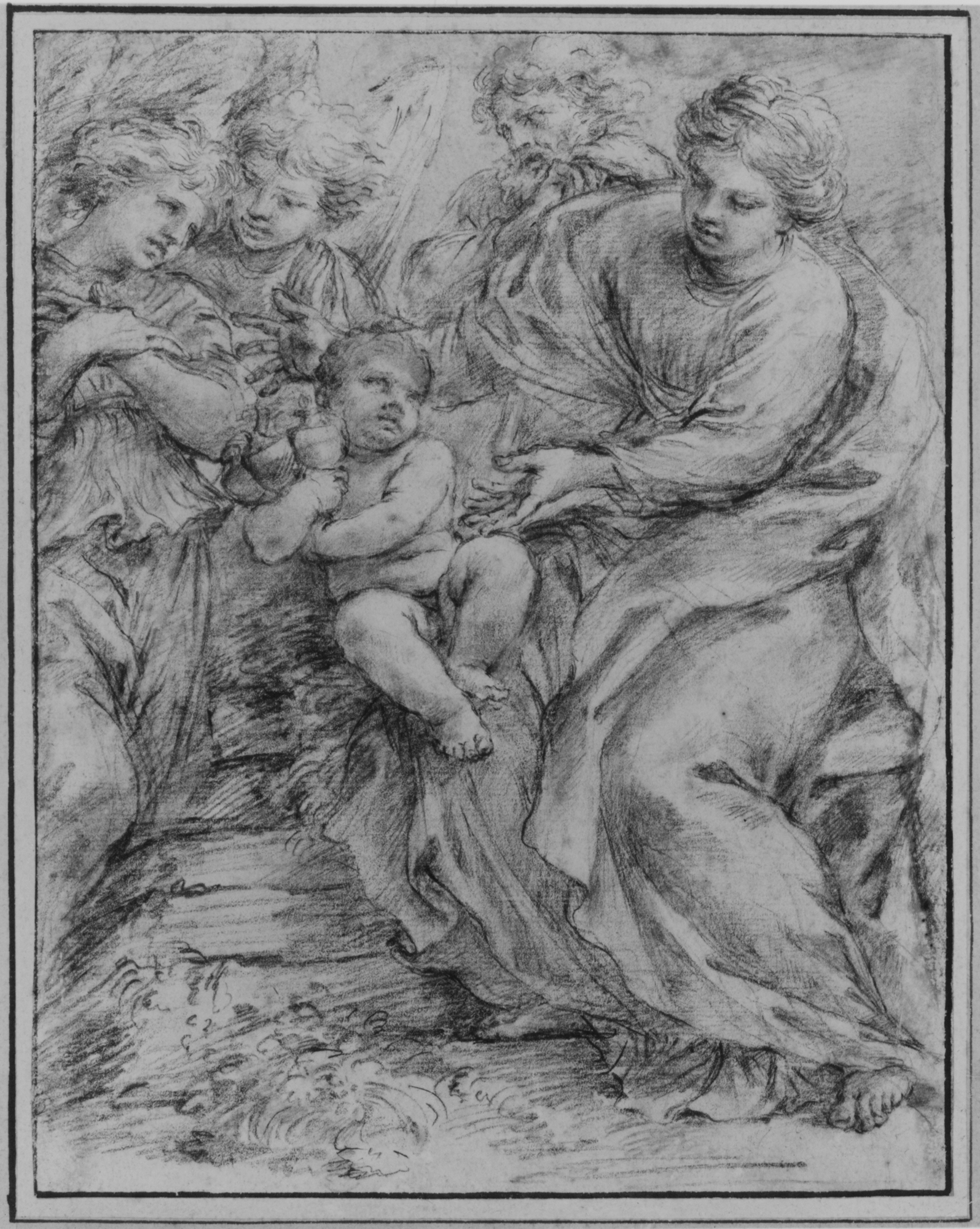The Holy Family with Two Angels
Alessandro Algardi Italian
Not on view
Trained in Bologna in the "Accademia degli Incaminati" founded by the Carracci, Algardi moved in 1625 to Rome, where he spent the rest of his life, excelling in relief and portrait sculpture. This drawing was surely a model for a relief sculpture or a metal plaquette: the handling of the silvery black chalk is vigorous and sculptural, and the high shine of the figures corresponds to the polish of a bronze relief. The figures are in the same scale as those of a bronze plaquette by Algardi of the ‘Rest on the Flight into Egypt’ in the Museum’s Collection (inv. 38.151.11) and the two works may have been connected with the same commission. The iconography of the drawing is unclear: the three jars held by the child may allude to the gifts brought by the three Magi.
It is quite possible that this sheet served as a demonstration drawing (‘modello’) for a relief sculpture, either in teracotta or bronze, to judge from both the nuanced treatment of the chiaroscuro, as well as the loose compositional and stylistic connections to various versions of small bronze plaquettes with the theme of the "Rest on the Flight to Egypt." The present state of research suggests that Algardi is not known to have cast his own metal sculptures. Especially the fact that the actual labor of execution may have been delegated could explain the reason why the composition in this drawing is so carefully worked out.
Algardi's style of drawing and pictorial composition were a direct response to Pietro da Cortona (1596-1669), the greatest painter of his generation in Rome and Algardi's close friend from the 1630's onward. This drawing demonstrates Algardi's masterful command of the chalk medium: passages of atmospheric stumping soften the vigorous, sculptural handling of the silvery black chalk. Full of movement, dramatic light, and tonal nuance, this rather finished drawing embodies the exuberance of the High Baroque manner in Rome. The exquisite pictorial qualities of this composition are rare in a sheet that was drawn by a sculptor, and indeed serve to point out Algardi's undisputed brilliance as a sculptor of reliefs.
The subject of the composition seems to be a variation on scenes of the "Holy Family," especially the "Rest on the Flight to Egypt." Of note, the seated Christ Child holds three jars, which may well turn out to be an allusion to the gifts brought to him by the three magi. There is much reason to think that this study was preparatory for a plaquette to be cast by other craftsmen, hence the highly detailed manner of drawing, which offers also a guideline as to the surface treatment of the relief. The figures in this composition study are in exact scale as those in the bronze plaquette version at the Metropolitan Museum of Art: the size of the composition (25.9 x 19.8 cm) is also comparable to that of the plaquette (26.7 x 33 cm). The Metropolitan plaquette does not have the angels on the upper left, but the figural types are closely comparable to those in the drawing.
It is clear that in the drawing, Algardi offers graphic equivalents for his manner of work as a sculptor of plaquettes (cast by other craftsman). The background in the drawing is subtly washed with gray-brown: in the plaquette the background is burnished. The high shine of the figures, with stumping to further unify areas of chiaroscuro, corresponds to the high polish of the figures in fairly projecting relief. The plaquette also shows abbreviated notation for the minor background details. In the drawing the grass and steps are characterized schematically with great bravura of line. The Drawing is glued onto a secondary paper support.
(Carmen C. Bambach)
Due to rights restrictions, this image cannot be enlarged, viewed at full screen, or downloaded.
This artwork is meant to be viewed from right to left. Scroll left to view more.






